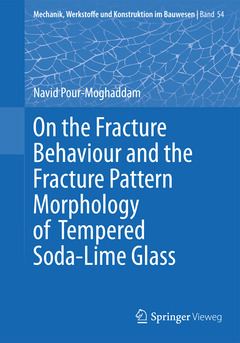Description
On the Fracture Behaviour and the Fracture Pattern Morphology of Tempered Soda-Lime Glass, 1st ed. 2020
Mechanik, Werkstoffe und Konstruktion im Bauwesen Series, Vol. 54
Author: Pour-Moghaddam Navid
Language: English
Subject for On the Fracture Behaviour and the Fracture Pattern...:
52.74 €
In Print (Delivery period: 15 days).
Add to cart
Publication date: 11-2019
Support: Print on demand
Support: Print on demand
Description
/li>Contents
/li>Biography
/li>Comment
/li>
The main criteria for assessing the load-bearing behaviour and risk potential of monolithic glass are its fragmentation and the morphology of the fragments. These depend strongly non-linearly on the strain energy density present in the glass at the time of fracture, which can be converted into fracture energy. Thus, the design and optimization of structural glazing in engineering requires both knowledge of the relevant parameters and mechanisms during the fracture process in glass and an understanding of the characteristics of the fracture structure. Based on fracture mechanics considerations and comprehensive experimental investigations, various aspects and physical quantities of fracture behaviour as well as characteristics and parameters of fracture pattern morphology of fragmented, tempered soda-lime glass were studied and correlated with the stored strain energy. The relationship between fragmentation behavior and strain energy was elaborated using the energy criterion in Linear Elastic Fracture Mechanics (LEFM) related to the initial strain energy before fragmentation and in the post-fracture state. Furthermore, a machine learning inspired approach for the prediction of 2D macro-scale fragmentation of tempered glass was developed and elaborated based on fracture mechanics considerations and statistical analysis of the fracture pattern morphology. A method was deduced and applied in which the fracture pattern of tempered glass is predicted and simulated by Voronoi tessellation of point patterns based on Bayesian spatial point statistics fed with energy conditions in LEFM.
Introduction.- Glass Properties and Refinement Processes.- Numerical Simulation of the Thermal Tempering Process.- Experimental Investigations into the Fragmentation of Tempered Glass.- Prediction of 2D Macro-Scale Fragmentation of Tempered Glass.- Investigations into the Phenomenon of Crack Branching.- Summary and Outlook.
Dr.-Ing. Navid Pour-Moghaddam studied Civil Engineering at the Technical University of Darmstadt. From 2011 to 2014 he was a project engineer at Werner Sobek Frankfurt with focus on structural engineering. Between 2014 and 2019 he earned his doctorate at the Institute of Structural Mechanics and Design (Prof. Dr.-Ing. Jens Schneider) in the field of glass construction. Since 2019 he has been working for Schüssler-Plan Frankfurt in the field of constructive engineering. He is a member of the Architects and Engineers Association of the City of Frankfurt.
Fragmentation and the morphology of the fragments Machine learning inspired approach Doctoral thesis in the series Mechanik, Werkstoffe und Konstruktion im Bauwesen
© 2024 LAVOISIER S.A.S.

